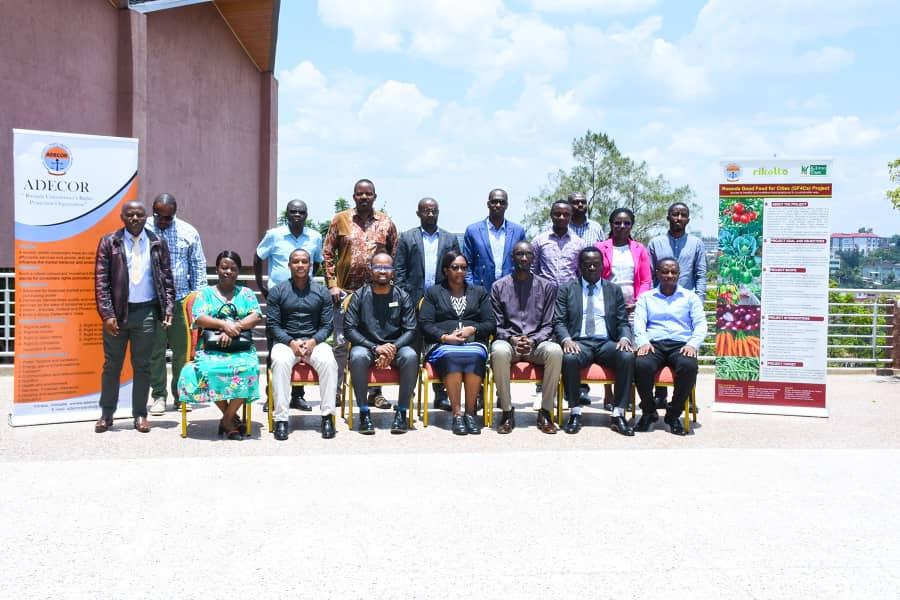
Damien Ndizeye, ADECOR Executive Secretary
Through the project “Good Food for Cities (GF4Cs)”, a 5-years initiative (2022-2026) implemented in Rubavu District, the Rwanda Consumers Rights Protection Organization (ADECOR), under the financial support of the Belgian NGO, RIKOLTO International SON, has conducted a rapid assessment of existing gaps in nutrition and food policies towards sustainable food systems in Rwanda. The aim was to generate evidences to base on in carrying out advocacy near policies makers and other decisions makers for adapting the existing policies and/or elaborating new ones to ensure good nutrition and sustainable food security for all Rwandan citizens.
The assessment used highly participatory and consultative approach involving major stakeholders, including high-level food producers and nutrition actors; involved extensive review of relevant documents, such as Rwanda’s Vision 2050, NST1, Rwanda national food and nutrition policy, National Food Safety Policy, Strategic Plan for Agriculture Transformation, National Agricultural Policy and others. It also involved reviewing reports from food and nutrition advocacy organizations and examined regional and international best practices regarding nutrition and food systems. The assessed policies are the Rwanda Nutrition and Food Policy Environment, Early Childhood Development Policy, National Food Safety Policy and the National Agriculture Policy.

Main gaps identified
The nutrition policy presents the nutrition-sensitive policies, strategies, and programmes but not for the nutrition-specific interventions and building an enabling environment. Policy implementation through the government expenditure on program, output, or activity levels may not perfectly match the intervention description as per the Lancet framework.
The Early Childhood Development Policy does not present the feasible mechanisms in the agriculture sector to be linked to the food policy.
The national food safety policy has limitations that relate to infrastructure. Whereas food safety is key to the consumers, the process begins with famers who, still lack essential storage facilities and maintenance channels for proper food safety towards markets. The food safety policy portrays gap on the linkage with climate change and how this could affect the levels of production, risks in dependence on the natural weather.
The national agriculture policy stresses the high level of intensification of technology in the agriculture sector to increase productivity. However, the use of technology among cooperative farmers and medium scale farmers is still low and limited, with low productivity. The engagement of the private sector for increased investment in agriculture is still limited. It should be noted that the national agricultural policy is not well structured to accommodate the volatility of basic agricultural products.
Challenges raised by grassroots farmers’ cooperatives in the food value chain
Farmers’ cooperatives face issues in the production at farm level, handling, packaging, and sale of the agricultural produce.
Famers have focused on producing for the market and this has affected malnutrition abatement as they tend to sell all produce with nothing left back home to the households.
Limited built-in infrastructure especially the storage facilities that would facilitate farmers to keep their produce for a prolonged period.
Famers lack markets for their produce especially in the high produce season.
Gaps in the coordination of mechanisms governing food systems in general show that a region that has produced more food than others cannot exchange these productions between different regions.
Farmers complain about the limitation in the supply of inputs. When inputs are available, their prices are high. Moreover, farmers periodically face lack of seeds for priority crops.
Farmers in Western Province producing for the DRC market, notably Goma and Bukavu, have experienced market and price volatility, especially during the COVID-19 period.
The food price volatility affects farmers in the food production process and affects the value chains with the price gaps from the farmers to the final markets.
Conclusion and recommendations
The Rwandan government is appreciated for having developed all the food systems policies that enable the implementation of various programmes to achieve a sustainable food system. The nutrition policy with nutrition-sensitive interventions and the food policy and agriculture development policy presents programmes in agriculture, social safety nets, early child development, and education that have enormous potential to enhance the scale and effectiveness of nutrition-specific interventions, increase food production and safety for the Rwandans. Evidence of the effectiveness of targeted agricultural programmes from the implementation reports viewed on maternal and child nutrition, strengthening of nutrition goals, actions, and the increase in food security portray efforts by the government to develop a sustainable food system. The policies present the various social safety nets, which are a powerful poverty reduction instrument. These social safety nets increase farmers’ incomes, improve nutrition for the households especially children and presents improved welfare for the majority of the households.
However, programme nutrition goals and interventions, and quality of services need to be strengthened. The assessment based on the respondents’ ideas and the assessments from the policy framework for the food and nutrition, provides some ideal recommendations on how to increase food production, reduce food losses, improve food safety, healthy and nutritious food consumption in Rwanda:
The government could do more by highlighting programmes that are oriented towards nutrition-specific interventions and building an enabling environment.
The government spending on nutrition-specific interventions, and nutrition sensitive interventions should be focused and follow the lancet framework to enable track of which interventions require more funds than the others.
The child development through the inter-sectoral linkages should also include the food production under the agriculture sector. The early childhood policy integrates other sector but no linkages with the agriculture sector, which is key for the Rwandan population and employing majority of the people.
The government needs to improve and or provide some of the basic infrastructures to the farmers who, still lack essential storage facilities and maintenance channels for proper food safety towards markets. This could be done through cooperatives and financial institutions with some little government subsidy.
The national agriculture policy need to accommodate and ensure a robust and efficient production that is linked to export of the produce and the policy should be deliberately formulated to speak to issues relating to currency management (import-export relation), inflation and food sufficiency.
Sensitization of farmers on the use of affordable technology, with some efforts by the government to provide the technology on the subsidized level. This could improve food production and increase incomes. However, this requires to be linked to other required infrastructures.
The government should facilitate farmers with access to markets and create linkages to regional and international markets.
The government could also establish agricultural centers that could be hubs for seeds multiplication to increase supply and reduce scarcity of quality seed required by the farmers. This could ensure quality of the produce and guarantee increased incomes to farmers and households engaged in food production.
The government could design policies that improve the prices of food producing farmers especially the youth and women who are the active farmers and are the majority of population.
Enhance coordination, monitoring and evaluation mechanisms on the implementation of policies from national level to community level as well as build strong platforms that groups together all of the people who have a stake on the food and agriculture value-chain which could help in attaining solutions to the farmers challenges.
There is need to strengthen strategies oriented at educating farmers on sustainable food production, distribution, sale, and safe consumption of agricultural food yield.
Enhance and incorporate scientific sound subjects that encourages healthy lifestyles of citizens in newly growing cities.
Mechanisms should be developed to identify and monitor vulnerable groups of people in our cities (especially secondary cities), with poor nutritional diets.
More close collaboration is encouraged between agriculture and health sectors (One Health Approach), and other sectors involved in food value chain.
The ongoing initiatives of the youth innovations/new technology use into local and regional good food distribution chains should be enhanced and heavily supported to facilitate farmers use soft technologies that could improve their produce and sustain the market demands. (End)
